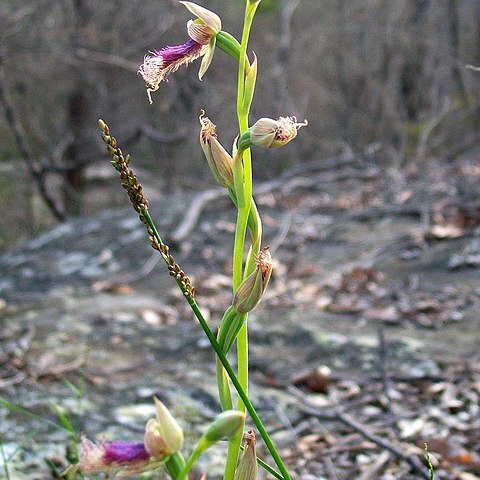Terrestrial orchids usually growing as single plants, uncommonly in tufts. A few species are leafless or appear so; several tropical species have a leaf that is only partially developed at flowering time, developing fully after flowering. Leaf single, basal, thick, ribbed, usually deeply channelled, occasionally 3-sided, dark green, base reddish. Racemes multi-flowered; peduncle slender to sturdy, with 2–5 sterile bracts. Flowers resupinate, dull-coloured. Tepals free, often with longitudinal stripes. Dorsal sepal broadly ovate, concave, often dorsally keeled, hooding the column and central part of the flower. Lateral sepals asymmetric, narrower than dorsal sepal, incurved beside labellum or divergent. Petals short, much smaller than sepals, asymmetric, apex often hooked to one side. Labellum resembling a beard, immovably attached to column base; lamina largest part of the flower, unlobed or obscurely lobed, flat or S-curved in profile; margins entire or with narrowly linear/tapered, tooth-like lobes, smooth or glandular; apex often extended into a tail, often glandular. Callus of elongate, crowded, colourful, hair-like calli, those towards the labellum apex often glandular, those towards the labellum base fused to form plates, ridges or tubercles; rarely the whole labellum surface smooth or covered with papillae. Column short, often ornamented with 2 spots or sham eyes and a frontal ridge, no basal foot. Pollinia 4, crescentic, friable, pale yellow, weakly attached to viscidium.
More
Raceme us. of few fls each with a distinct pedicel; floral bracts us. exceeding ovary. Per. glab.; dorsal sepal uppermost, broad, concave; lateral sepals subsimilar, only slightly shorter; petals much shorter, broadly falcate. Labellum mostly > sepals, sessile, broadly elliptic, the greater part of the inner surface us. bearded with long, capillary, strongly coloured processes which also fringe the margin, the processes us. shorter near the base and often lacking towards the tip, leaving a narrow ligulate apex unadorned. Column short and wide with broad wings flanking the circular stigma; anther terminal, papillose, pollinia 2 per cell, pollen finely granular; rostellum short. Plants terrestrial, glab.; tubers ovoid, new one produced at base of parent plant. Lf sheathing at base, narrow-linear, channelled, sts absent; cauline bracts few, short, us. foliaceous. Genus of c. 11 spp., mostly Australian, but recorded also from New Guinea and New Caledonia. The 3 spp. known in N.Z. occur also in Australia.
Found in forested habitats, shrubland and heathland, mostly in freely draining soil, but some species favour poorly drained sites and seasonally wet habitats.

